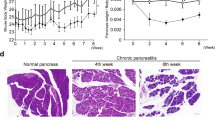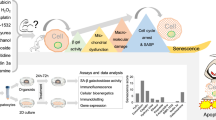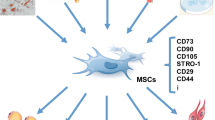Abstract
Autoimmune hepatitis (AIH) is a severe globally distributed liver disease that could occur at any age. Human menstrual blood-derived stem cells (MenSCs) have shown therapeutic effect in acute lung injury and liver failure. However, their role in the curative effect of AIH remains unclear. Here, a classic AIH mouse model was constructed through intravenous injection with concanavalin A (Con A). MenSCs were intravenously injected while Con A injection in the treatment groups. The results showed that the mortality by Con A injection was significantly decreased by MenSCs treatment and liver function tests and histological analysis were also ameliorated. The results of phosphoproteomic analysis and RNA-seq revealed that MenSCs improved AIH, mainly by apoptosis and c-Jun N-terminal kinase/mitogen-activated protein signaling pathways. Apoptosis analysis demonstrated that the protein expression of cleaved caspase 3 was increased by Con A injection and reduced by MenSCs transplantation, consistent with the TUNEL staining results. An AML12 co-culture system and JNK inhibitor (SP600125) were used to verify the JNK/MAPK and apoptosis signaling pathways. These findings suggested that MenSCs could be a promising strategy for AIH.
Similar content being viewed by others
References
Mieli-Vergani G, Vergani D, Czaja AJ, Manns MP, Krawitt EL, Vierling JM, Lohse AW, Montano-Loza AJ. Autoimmune hepatitis. Nat Rev Dis Primers 2018; 4(1): 18017
Smolka V, Tkachyk O, Ehrmann J, Karaskova E, Zapalka M, Volejnikova J. Acute onset of autoimmune hepatitis in children and adolescents. Hepatobiliary Pancreat Dis Int 2020; 19(1): 17–21
Mühling T, Rohrbach H, Schepp W, Gundling F. Overlap of concurrent extrahepatic autoimmune diseases is associated with milder disease severity of newly diagnosed autoimmune hepatitis. Hepatobiliary Pancreat Dis Int 2021; 20(1): 21–27
Friedenstein AJ, Petrakova KV, Kurolesova AI, Frolova GP. Heterotopic of bone marrow. Analysis of precursor cells for osteogenic and hematopoietic tissues. Transplantation 1968; 6(2): 230–247
Chen L, Zhang C, Chen L, Wang X, Xiang B, Wu X, Guo Y, Mou X, Yuan L, Chen B, Wang J, Xiang C. Human Menstrual blood-derived stem cells ameliorate liver fibrosis in mice by targeting hepatic stellate cells via paracrine mediators. Stem Cells Transl Med 2017; 6(1): 272–284
Bai M, Zhang L, Fu B, Bai J, Zhang Y, Cai G, Bai X, Feng Z, Sun S, Chen X. IL-17A improves the efficacy of mesenchymal stem cells in ischemic-reperfusion renal injury by increasing Treg percentages by the COX-2/PGE2 pathway. Kidney Int 2018; 93(4): 814–825
Lee CW, Chen YF, Wu HH, Lee OK. Historical perspectives and advances in mesenchymal stem cell research for the treatment of liver diseases. Gastroenterology 2018; 154(1): 46–56
Zhao J, Li Y, Jia R, Wang J, Shi M, Wang Y. Mesenchymal stem cells-derived exosomes as dexamethasone delivery vehicles for autoimmune hepatitis therapy. Front Bioeng Biotechnol 2021; 9: 650376
Chen ZK, Chen DZ, Cai C, Jin LL, Xu J, Tu YL, Huang XZ, Xu JL, Chen MZ, Xue FB, Lan XL, Wang XD, Ge YL, Sun HL, Chen YP. BMSCs attenuate hepatic fibrosis in autoimmune hepatitis through regulation of LMO7-AP1-TGFβ signaling pathway. Eur Rev Med Pharmacol Sci 2021; 25(3): 1600–1611
Chen L, Lu FB, Chen DZ, Wu JL, Hu ED, Xu LM, Zheng MH, Li H, Huang Y, Jin XY, Gong YW, Lin Z, Wang XD, Chen YP. BMSCs-derived miR-223-containing exosomes contribute to liver protection in experimental autoimmune hepatitis. Mol. Immunol 2018; 93: 38–46
Rodríguez-Fuentes DE, Fernández-Garza LE, Samia-Meza JA, Barrera-Barrera SA, Caplan AI, Barrera-Saldaña HA. Mesenchymal stem cells current clinical applications: a systematic review. Arch Med Res 2021; 52(1): 93–101
Wu X, Luo Y, Chen J, Pan R, Xiang B, Du X, Xiang L, Shao J, Xiang C. Transplantation of human menstrual blood progenitor cells improves hyperglycemia by promoting endogenous progenitor differentiation in type 1 diabetic mice. Stem Cells Dev 2014; 23(11): 1245–1257
Xiang B, Chen L, Wang X, Zhao Y, Wang Y, Xiang C. Transplantation of menstrual blood-derived mesenchymal stem cells promotes the repair of LPS-induced acute lung injury. Int J Mol Sci 2017; 18(4): E689
Cao H, Yang J, Yu J, Pan Q, Li J, Zhou P, Li Y, Pan X, Li J, Wang Y, Li L. Therapeutic potential of transplanted placental mesenchymal stem cells in treating Chinese miniature pigs with acute liver failure. BMC Med 2012; 10(1): 56
Wang HX, Liu M, Weng SY, Li JJ, Xie C, He HL, Guan W, Yuan YS, Gao J. Immune mechanisms of concanavalin A model of autoimmune hepatitis. World J Gastroenterol 2012; 18(2): 119–125
Hao J, Sun W, Xu H. Pathogenesis of concanavalin A induced autoimmune hepatitis in mice. Int Immunopharmacol 2022; 102: 108411
Tiegs G, Hentschel J, Wendel A. A T cell-dependent experimental liver injury in mice inducible by concanavalin A. J Clin Invest 1992; 90(1): 196–203
Yu Q, Liu T, Li S, Feng J, Wu L, Wang W, Chen K, Xia Y, Niu P, Xu L, Wang F, Dai W, Zhou Y, Guo C. The protective effects of levo-tetrahydropalmatine on ConA-induced liver injury are via TRAF6/JNK signaling. Mediators Inflamm 2018; 2018: 4032484
El-Agamy DS, Shaaban AA, Almaramhy HH, Elkablawy S, Elkablawy MA. Pristimerin as a novel hepatoprotective agent against experimental autoimmune hepatitis. Front Pharmacol 2018; 9: 292
Maiuri MC, Zalckvar E, Kimchi A, Kroemer G. Self-eating and self-killing: crosstalk between autophagy and apoptosis. Nat Rev Mol Cell Biol 2007; 8(9): 741–752
Yue J, López JM. Understanding MAPK signaling pathways in apoptosis. Int J Mol Sci 2020; 21(7): E2346
Deng Y, Ren X, Yang L, Lin Y, Wu X. A JNK-dependent pathway is required for TNFα-induced apoptosis. Cell 2003; 115(1): 61–70
Bennett BL, Sasaki DT, Murray BW, O’Leary EC, Sakata ST, Xu W, Leisten JC, Motiwala A, Pierce S, Satoh Y, Bhagwat SS, Manning AM, Anderson DW. SP600125, an anthrapyrazolone inhibitor of Jun N-terminal kinase. Proc Natl Acad Sci USA 2001; 98(24): 13681–13686
Wu X, Luo Y, Chen J, Pan R, Xiang B, Du X, Xiang L, Shao J, Xiang C. Transplantation of human menstrual blood progenitor cells improves hyperglycemia by promoting endogenous progenitor differentiation in type 1 diabetic mice. Stem Cells Dev 2014; 23(11): 1245–1257
Diao H, Kon S, Iwabuchi K, Kimura C, Morimoto J, Ito D, Segawa T, Maeda M, Hamuro J, Nakayama T, Taniguchi M, Yagita H, Van Kaer L, Onóe K, Denhardt D, Rittling S and Uede T. Osteopontin as a mediator of NKT cell function in T cell-mediated liver diseases. Immunity 2004; 21(4): 539–550
Li S, Zhong X, Kan X, Gu L, Sun H, Zhang G, Liu X. De novo transcriptome analysis of Thitarodes jiachaensis before and after infection by the caterpillar fungus, Ophiocordyceps sinensis. Gene 2016; 580(2): 96–103
Mao X, Cai T, Olyarchuk JG, Wei L. Automated genome annotation and pathway identification using the KEGG Orthology (KO) as a controlled vocabulary. Bioinformatics 2005; 21(19): 3787–3793
Kanehisa M, Araki M, Goto S, Hattori M, Hirakawa M, Itoh M, Katayama T, Kawashima S, Okuda S, Tokimatsu T, Yamanishi Y. KEGG for linking genomes to life and the environment. Nucleic Acids Res 2008; 36(Database issue): D480–D484
Ye T, Wang T, Yang X, Fan X, Wen M, Shen Y, Xi X, Men R, Yang L. Comparison of concanavalin A-induced murine autoimmune hepatitis models. Cell Physiol Biochem 2018; 46(3): 1241–1251
Meng X, Ichim TE, Zhong J, Rogers A, Yin Z, Jackson J, Wang H, Ge W, Bogin V, Chan KW, Thébaud B, Riordan NH. Endometrial regenerative cells: a novel stem cell population. J Transl Med 2007; 5(1): 57
Chen J, Du X, Chen Q, Xiang C. Effects of donors’ age and passage number on the biological characteristics of menstrual blood-derived stem cells. Int J Clin Exp Pathol 2015; 8(11): 14584–14595
Gargett CE, Schwab KE, Deane JA. Endometrial stem/progenitor cells: the first 10 years. Hum Reprod Update 2016; 22(2): 137–163
Cuenca J, Le-Gatt A, Castillo V, Belletti J, Díaz M, Kurte G M, Gonzalez PL, Alcayaga-Miranda F, Schuh CMAP, Ezquer F, Ezquer M, Khoury M. The reparative abilities of menstrual stem cells modulate the wound matrix signals and improve cutaneous regeneration. Front Physiol 2018; 9: 464
Luz-Crawford P, Torres MJ, Noël D, Fernandez A, Toupet K, Alcayaga-Miranda F, Tejedor G, Jorgensen C, Illanes SE, Figueroa FE, Djouad F, Khoury M. The immunosuppressive signature of menstrual blood mesenchymal stem cells entails opposite effects on experimental arthritis and graft versus host diseases. Stem Cells 2016; 34(2): 456–469
Irwin M, Tare M, Singh A, Puli OR, Gogia N, Riccetti M, Deshpande P, Kango-Singh M, Singh A. A positive feedback loop of Hippo- and c-Jun-amino-terminal kinase signaling pathways regulates amyloid-beta-mediated neurodegeneration. Front Cell Dev Biol 2020; 8: 117
Gogia N, Sarkar A, Mehta AS, Ramesh N, Deshpande P, Kango-Singh M, Pandey UB, Singh A. Inactivation of Hippo and cJun-N-terminal kinase (JNK) signaling mitigate FUS mediated neurodegeneration in vivo. Neurobiol Dis 2020; 140: 104837
Babamale AO, Chen ST. Nod-like receptors: critical intracellular sensors for host protection and cell death in microbial and parasitic infections. Int J Mol Sci 2021; 22(21): 11398
Henning RJ, Bourgeois M, Harbison RD. Poly(ADP-ribose) polymerase (PARP) and PARP inhibitors: mechanisms of action and role in cardiovascular disorders. Cardiovasc Toxicol 2018; 18(6): 493–506
Sairanen T, Szepesi R, Karjalainen-Lindsberg ML, Saksi J, Paetau A, Lindsberg PJ. Neuronal caspase-3 and PARP-1 correlate differentially with apoptosis and necrosis in ischemic human stroke. Acta Neuropathol 2009; 118(4): 541–552
Jin Z, El-Deiry WS. Overview of cell death signaling pathways. Cancer Biol Ther 2005; 4(2): 139–163
Engelman JA, Luo J, Cantley LC. The evolution of phosphatidylinositol 3-kinases as regulators of growth and metabolism. Nat Rev Genet 2006; 7(8): 606–619
Herrera SC, Bach EA. The emerging roles of JNK signaling in Drosophila stem cell homeostasis. Int J Mol Sci 2021; 22(11): 5519
Yin S, Shi Q, Shao W, Zhang C, Zhang Y, Qiu X, Huang J. Hepatocyte-derived Igκ exerts a protective effect against ConA-induced acute liver injury. Int J Mol Sci 2020; 21(24): E9379
El-Kashef DH, Abdelrahman RS. Montelukast ameliorates concanavalin A-induced autoimmune hepatitis in mice via inhibiting TNF-α/JNK signaling pathway. Toxicol Appl Pharmacol 2020; 393: 114931
Li X, Zhang Y, Liang Y, Cui Y, Yeung SC, Ip MS, Tse HF, Lian Q, Mak JC. iPSC-derived mesenchymal stem cells exert SCF-dependent recovery of cigarette smoke-induced apoptosis/proliferation imbalance in airway cells. J Cell Mol Med 2017; 21(2): 265–277
Li X, Hong Y, He H, Jiang G, You W, Liang X, Fu Q, Han S, Lian Q, Zhang Y. FGF21 mediates mesenchymal stem cell senescence via regulation of mitochondrial dynamics. Oxid Med Cell Longev 2019; 2019: 4915149
Li CL, Leng Y, Zhao B, Gao C, Du FF, Jin N, Lian QZ, Xu SY, Yan GL, Xia JJ, Zhuang GH, Fu QL, Qi ZQ. Human iPSC-MSC-derived xenografts modulate immune responses by inhibiting the cleavage of caspases. Stem Cells 2017; 35(7): 1719–1732
Zheng Y, Zhang M, Zhao Y, Chen J, Li B, Cai W. JNK inhibitor SP600125 protects against lipopolysaccharide-induced acute lung injury via upregulation of claudin-4. Exp Ther Med 2014; 8(1): 153–158
Moon DO, Choi YH, Kim GY. Role of p21 in SP600125-induced cell cycle arrest, endoreduplication, and apoptosis. Cell Mol Life Sci 2011; 68(19): 3249–3260
Lian Q, Zhang Y, Liang X, Gao F, Tse HF. Directed differentiation of human-induced pluripotent stem cells to mesenchymal stem cells. Methods Mol Biol 2016; 1416: 289–298
Bloor AJC, Patel A, Griffin JE, Gilleece MH, Radia R, Yeung DT, Drier D, Larson LS, Uenishi GI, Hei D, Kelly K, Slukvin I, Rasko JEJ. Production, safety and efficacy of iPSC-derived mesenchymal stromal cells in acute steroid-resistant graft versus host disease: a phase I, multicenter, open-label, dose-escalation study. Nat Med 2020; 26(11): 1720–1725
Chen L, Qu J, Cheng T, Chen X, Xiang C. Menstrual blood-derived stem cells: toward therapeutic mechanisms, novel strategies, and future perspectives in the treatment of diseases. Stem Cell Res Ther 2019; 10(1): 406
Acknowledgements
This project was supported by Science Fund for Creative Research Groups of the National Natural Science Foundation of China (No. 81721091) and The Independent Task of State Key Laboratory for Diagnosis and Treatment of Infectious Diseases, The First Affiliated Hospital, Zhejiang University School of Medicine. The authors wish to thank Charlie Xiang’s laboratory for kindly providing human MenSCs and Tsingke Biological Technology for the RNA-seq and data processing.
Author information
Authors and Affiliations
Corresponding author
Ethics declarations
Fen Zhang, Lanlan Xiao, Ya Yang, Menghao Zhou, Yalei Zhao, Zhongyang Xie, Xiaoxi Ouyang, Feiyang Ji, Shima Tang and Lanjuan Li declare that they have no conflict of interest. All institutional and national guidelines for the care and use of laboratory animals were followed.
Supplementary information
Rights and permissions
About this article
Cite this article
Zhang, F., Xiao, L., Yang, Y. et al. Human menstrual blood-derived stem cells alleviate autoimmune hepatitis via JNK/MAPK signaling pathway in vivo and in vitro. Front. Med. 17, 534–548 (2023). https://doi.org/10.1007/s11684-022-0953-y
Received:
Accepted:
Published:
Issue Date:
DOI: https://doi.org/10.1007/s11684-022-0953-y




